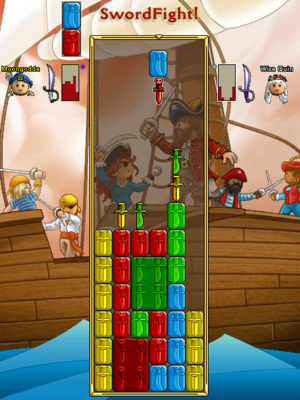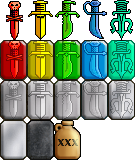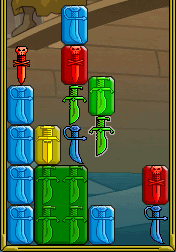Difference between revisions of "Swordfight"
m (→Purple blocks) |
m (→Purple blocks) |
||
| Line 24: | Line 24: | ||
== Purple blocks == | == Purple blocks == | ||
{{testing}} | {{testing}} | ||
| − | Purple blocks are special pieces that can appear as part of a drop pattern. They will not fuse together, but can be cleared using a breaker of any color. The breaker will clear groups of purple blocks, as well as any regular blocks of its color that are touching the breaker directly. Markings on the block indicate how many times pieces have entered the board and not cleared it. If it remains uncleared for | + | Purple blocks are special pieces that can appear as part of a drop pattern. They will not fuse together, but can be cleared using a breaker of any color. The breaker will clear groups of purple blocks, as well as any regular blocks of its color that are touching the breaker directly. Markings on the block indicate how many times pieces have entered the board and not cleared it. If it remains uncleared for 5 drops, it will change into an unclearable black block. |
| + | [[Image:Sword pieces purple.png|frame|center|The purple blocks with markings]] | ||
= Achieving the Greatest Breaks = | = Achieving the Greatest Breaks = | ||
Revision as of 01:18, 22 July 2010
Swordfighting (often abbreviated as sf) is a multiplayer puzzle. The puzzle can be played in many different settings. It is available from the tournament board or as a parlor game. (When played with more than two people, the swordfight is known as a brawl.) Players can challenge NPPs or other players to a swordfight. In addition, the final phase of a sea battle against brigands is a swordfight. While in Atlantis, players may be challenged to brawls by an NPP and the entire ship may enter a swordfight while inside a citadel.
Swordfighting is free to play three days a week. Swordfighting at sea and via a player challenge is always free.
Contents
[hide]Controls
Though controls can be customized under the options screen, the default controls are as follows:
- Left and Right arrows - move left and right
- Up and Down arrows - rotate counter-clockwise and clockwise
- Space - drops quickly
- A and S - switches opponent up/down
- [ and ] - same as A and S
Gameplay
Swordfighting is about clearing pieces from your board in order to fill up your opponent's board. As the fight progresses, boards become more difficult to keep clear as there are more pieces in play and incoming attacks get larger. Pieces enter the board two at a time, from the fourth column of the board. When the fourth column becomes completely full (meaning no more pieces can enter the board) the player is defeated.
Pieces
There are two different types of pieces: solid blocks and cutout "breakers". These pieces come in one of four colors: red, yellow, green, and blue. Additionally, there's also an aqua block in the shape of a trident if you are fighting a dragoon. Each of the colors have a distinct shape and a recognizable outline. You will also see grey blocks throughout the course of a swordfight as your opponent breaks his or her blocks. On ships, you may also see solid black blocks (if your ship has taken damage) or jug-shaped blocks (if your ship is out of rum).
Clearing pieces
Sword pieces fall from the top of the screen. Breakers will shatter all connecting pieces of the same color and send an attack proportional to the size of the shatter to your opponent. These attacks are described in detail below. Solid blocks of the same color can be merged to form larger blocks. This happens automatically when the blocks are placed together in a 2x2 or larger rectangular formation. Merged blocks will send sword strikes to your opponent when cleared, depending on their size.
Purple blocks
| The subject of this article is undergoing testing and may be changed before implementation. | |
| Please see discussion on the talk page or check out the testing on the Ice Ocean. |
Purple blocks are special pieces that can appear as part of a drop pattern. They will not fuse together, but can be cleared using a breaker of any color. The breaker will clear groups of purple blocks, as well as any regular blocks of its color that are touching the breaker directly. Markings on the block indicate how many times pieces have entered the board and not cleared it. If it remains uncleared for 5 drops, it will change into an unclearable black block.
Achieving the Greatest Breaks
Pieces of the same color in blocks solidify into a large block if they are arranged in a 2 x 2 or greater rectangular formation. When broken, vertical blocks send vertical swords to your opponent; horizontal blocks send horizontal swords (which can be difficult to overcome if well-placed).
These swords appear as an immovable image of a sword for one turn. They become a mass of grey blocks the next turn, and fall down where possible. On the third turn, those grey blocks will show a sword image (like regular pieces but without the color). Finally the grey blocks turn into regular pieces on the fourth turn.
Minor Breaks (Sprinkles)
When you shatter pieces that were not part of a larger block, they become single grey blocks that fall on your opponent. These, too, can be devastating if placed correctly. Without using a chain, you create one sprinkle block for every two loose blocks shattered. Breakers count as loose blocks.
Chaining
The most devastating breaks come from chains. When a block is broken, the pieces above it fall onto the pieces below. Being able to make double, triple, bingo, donkey, vegas, or greater chains, will multiply your attacks.
How Breaks Strike Opponents
Note: Strikes against NPPs do not follow these rules.
To learn more about how strikes affect opponents, read the excellent forum posts by Tedv, Robertdonald, and Jack in the External Links section below.
Influences
This puzzle's mechanics were heavily influenced by Super Puzzle Fighter 2 Turbo for arcades and later various consoles, which later influenced Puzzle Kombat (part of Mortal Kombat Deception for the PlayStation 2).
Historical Notes
- In the original version of the sea battle swordfight, a maximum of 10 rows of black blocks could be achieved (if a ship had become fully damaged). This was lowered to 6 rows in Beta release 2003-11-22. The amount of black blocks a cannonball added was not changed, just that the maximum damage level for swordfighting was lowered.
- Rum bottles in the sea battle swordfight in release 2005-04-26. Previously if a ship was out of rum, there was no penalty in swordfights.
Ultimate list
| Cerulean | Emerald | Ice |
|---|---|---|
| Jade | Meridian | Obsidian |
| Opal | ||
Trophies
External/Other Links
- Black Death Sword and Sprinkle Placement Guide
- Commonly discussed ideas from Game Design
- Official game documents
- Tedv's Everything about Everything about Swords post (somewhat outdated)
- RobertDonald's Swordfighting Guide Relevant
- Jack's Strike Pattern Inner Workings explains what your opponent gets
- Rusty Cutlass Sword pattern tool calculates what Jack said for a particular sword.
- Alexaleo's Breaker Stacking Swordfighting Video
- Swordfighting Video
- Everything about Everything about Swords
| |||
| See also: Swordfighting | Drop pattern | Brawl | |||
| |
| See also: Tournament |














